LML6005: Analyzing Visa Compliance and Cancellation in Migration Law
VerifiedAdded on 2023/06/10
|6
|1104
|94
Homework Assignment
AI Summary
This assignment provides a detailed analysis of visa compliance and cancellation under Australian Migration Law, specifically addressing scenarios related to Narelle Patel's Visitor Visa cancellation. It examines the cancellation power under Section 116(3) of the Migration Act, 1958, the implications for Bridging E visas, and the possibility of applying for a Partner visa. The assignment also clarifies the conditions attached to such visas and references relevant legislation and scholarly articles, offering a comprehensive understanding of the legal framework governing migration in Australia. Desklib provides students access to a wide range of similar assignments and past papers for academic support.

Running head: MIGRATION LAW
MIGRATION LAW
Name of the Student
Name of the University
Author Note
MIGRATION LAW
Name of the Student
Name of the University
Author Note
Paraphrase This Document
Need a fresh take? Get an instant paraphrase of this document with our AI Paraphraser
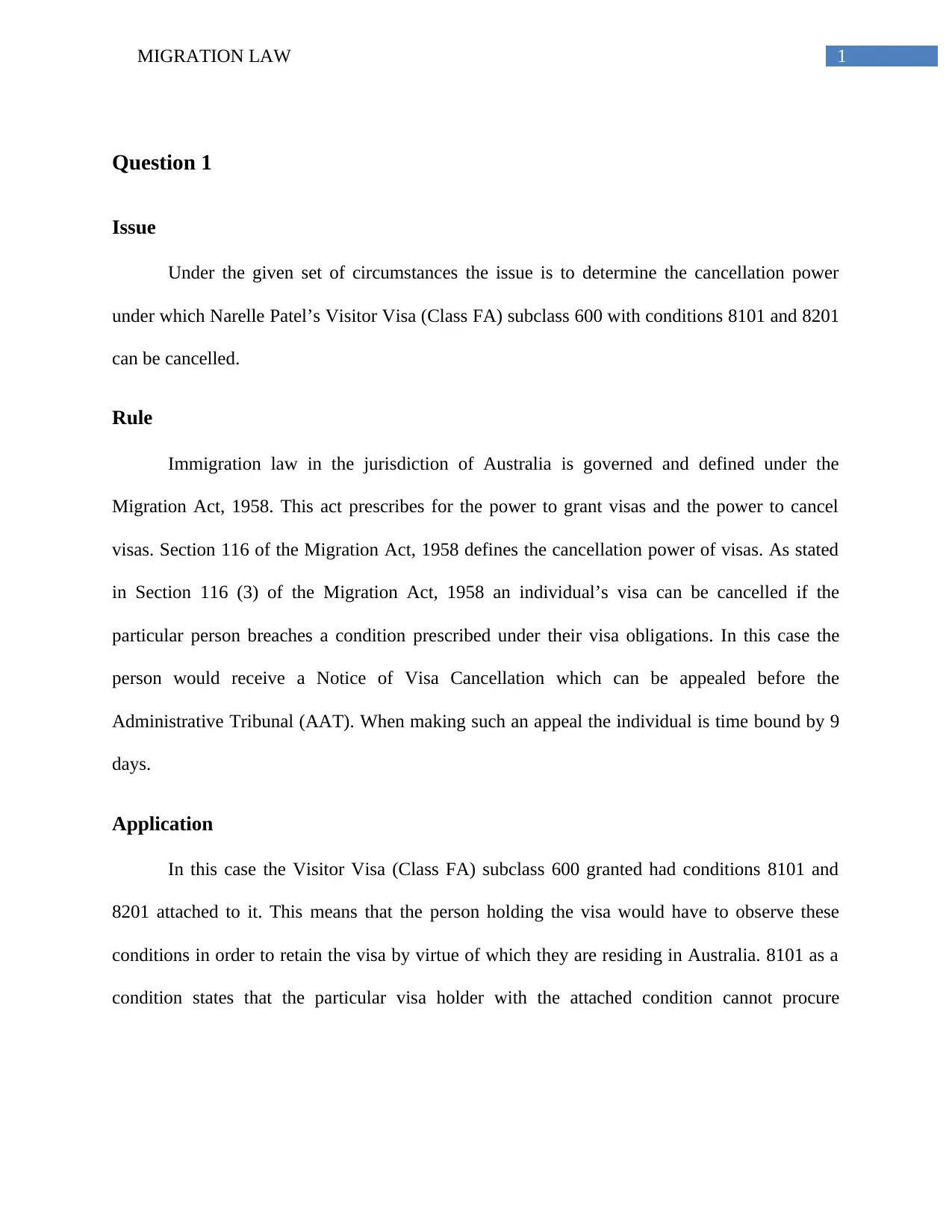
1MIGRATION LAW
Question 1
Issue
Under the given set of circumstances the issue is to determine the cancellation power
under which Narelle Patel’s Visitor Visa (Class FA) subclass 600 with conditions 8101 and 8201
can be cancelled.
Rule
Immigration law in the jurisdiction of Australia is governed and defined under the
Migration Act, 1958. This act prescribes for the power to grant visas and the power to cancel
visas. Section 116 of the Migration Act, 1958 defines the cancellation power of visas. As stated
in Section 116 (3) of the Migration Act, 1958 an individual’s visa can be cancelled if the
particular person breaches a condition prescribed under their visa obligations. In this case the
person would receive a Notice of Visa Cancellation which can be appealed before the
Administrative Tribunal (AAT). When making such an appeal the individual is time bound by 9
days.
Application
In this case the Visitor Visa (Class FA) subclass 600 granted had conditions 8101 and
8201 attached to it. This means that the person holding the visa would have to observe these
conditions in order to retain the visa by virtue of which they are residing in Australia. 8101 as a
condition states that the particular visa holder with the attached condition cannot procure
Question 1
Issue
Under the given set of circumstances the issue is to determine the cancellation power
under which Narelle Patel’s Visitor Visa (Class FA) subclass 600 with conditions 8101 and 8201
can be cancelled.
Rule
Immigration law in the jurisdiction of Australia is governed and defined under the
Migration Act, 1958. This act prescribes for the power to grant visas and the power to cancel
visas. Section 116 of the Migration Act, 1958 defines the cancellation power of visas. As stated
in Section 116 (3) of the Migration Act, 1958 an individual’s visa can be cancelled if the
particular person breaches a condition prescribed under their visa obligations. In this case the
person would receive a Notice of Visa Cancellation which can be appealed before the
Administrative Tribunal (AAT). When making such an appeal the individual is time bound by 9
days.
Application
In this case the Visitor Visa (Class FA) subclass 600 granted had conditions 8101 and
8201 attached to it. This means that the person holding the visa would have to observe these
conditions in order to retain the visa by virtue of which they are residing in Australia. 8101 as a
condition states that the particular visa holder with the attached condition cannot procure
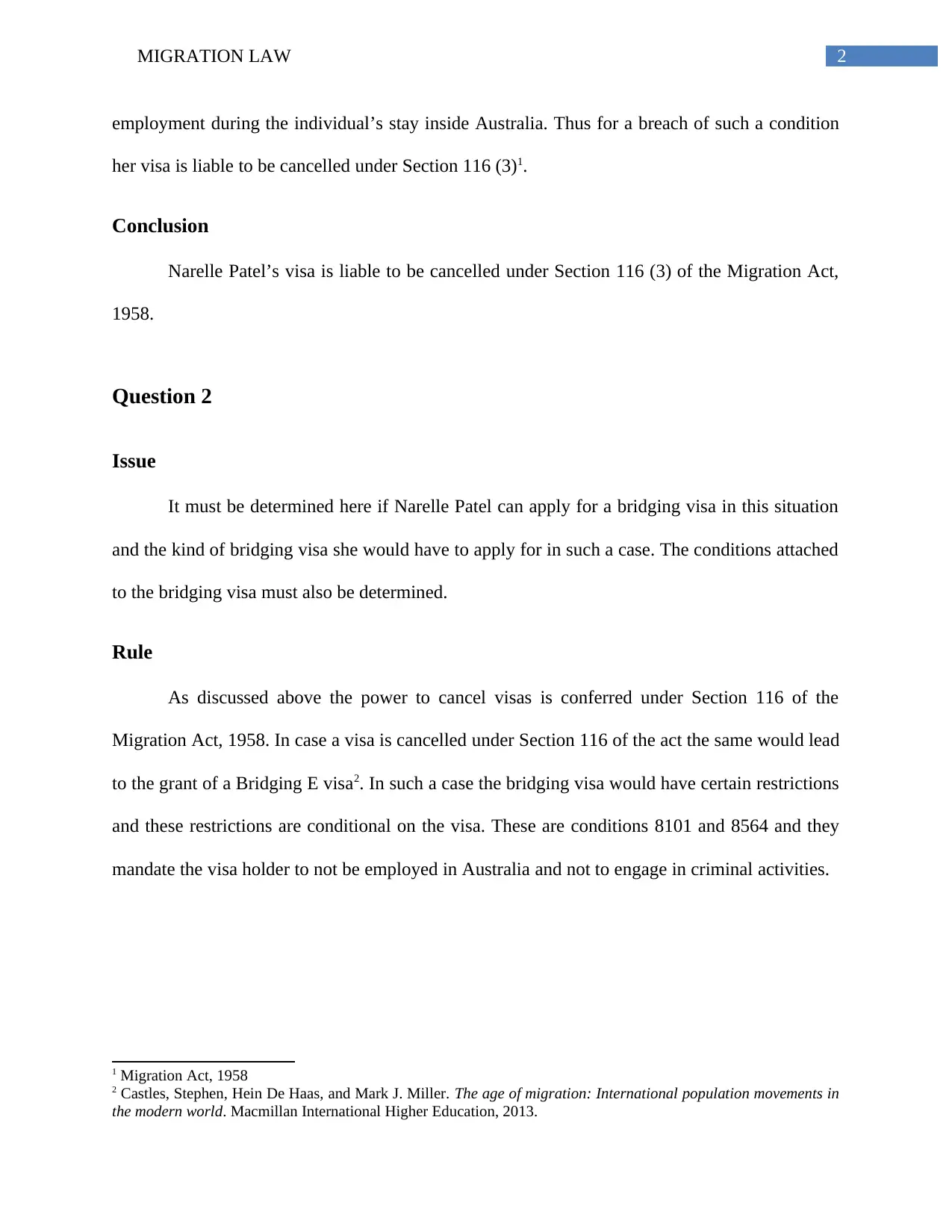
2MIGRATION LAW
employment during the individual’s stay inside Australia. Thus for a breach of such a condition
her visa is liable to be cancelled under Section 116 (3)1.
Conclusion
Narelle Patel’s visa is liable to be cancelled under Section 116 (3) of the Migration Act,
1958.
Question 2
Issue
It must be determined here if Narelle Patel can apply for a bridging visa in this situation
and the kind of bridging visa she would have to apply for in such a case. The conditions attached
to the bridging visa must also be determined.
Rule
As discussed above the power to cancel visas is conferred under Section 116 of the
Migration Act, 1958. In case a visa is cancelled under Section 116 of the act the same would lead
to the grant of a Bridging E visa2. In such a case the bridging visa would have certain restrictions
and these restrictions are conditional on the visa. These are conditions 8101 and 8564 and they
mandate the visa holder to not be employed in Australia and not to engage in criminal activities.
1 Migration Act, 1958
2 Castles, Stephen, Hein De Haas, and Mark J. Miller. The age of migration: International population movements in
the modern world. Macmillan International Higher Education, 2013.
employment during the individual’s stay inside Australia. Thus for a breach of such a condition
her visa is liable to be cancelled under Section 116 (3)1.
Conclusion
Narelle Patel’s visa is liable to be cancelled under Section 116 (3) of the Migration Act,
1958.
Question 2
Issue
It must be determined here if Narelle Patel can apply for a bridging visa in this situation
and the kind of bridging visa she would have to apply for in such a case. The conditions attached
to the bridging visa must also be determined.
Rule
As discussed above the power to cancel visas is conferred under Section 116 of the
Migration Act, 1958. In case a visa is cancelled under Section 116 of the act the same would lead
to the grant of a Bridging E visa2. In such a case the bridging visa would have certain restrictions
and these restrictions are conditional on the visa. These are conditions 8101 and 8564 and they
mandate the visa holder to not be employed in Australia and not to engage in criminal activities.
1 Migration Act, 1958
2 Castles, Stephen, Hein De Haas, and Mark J. Miller. The age of migration: International population movements in
the modern world. Macmillan International Higher Education, 2013.
⊘ This is a preview!⊘
Do you want full access?
Subscribe today to unlock all pages.

Trusted by 1+ million students worldwide
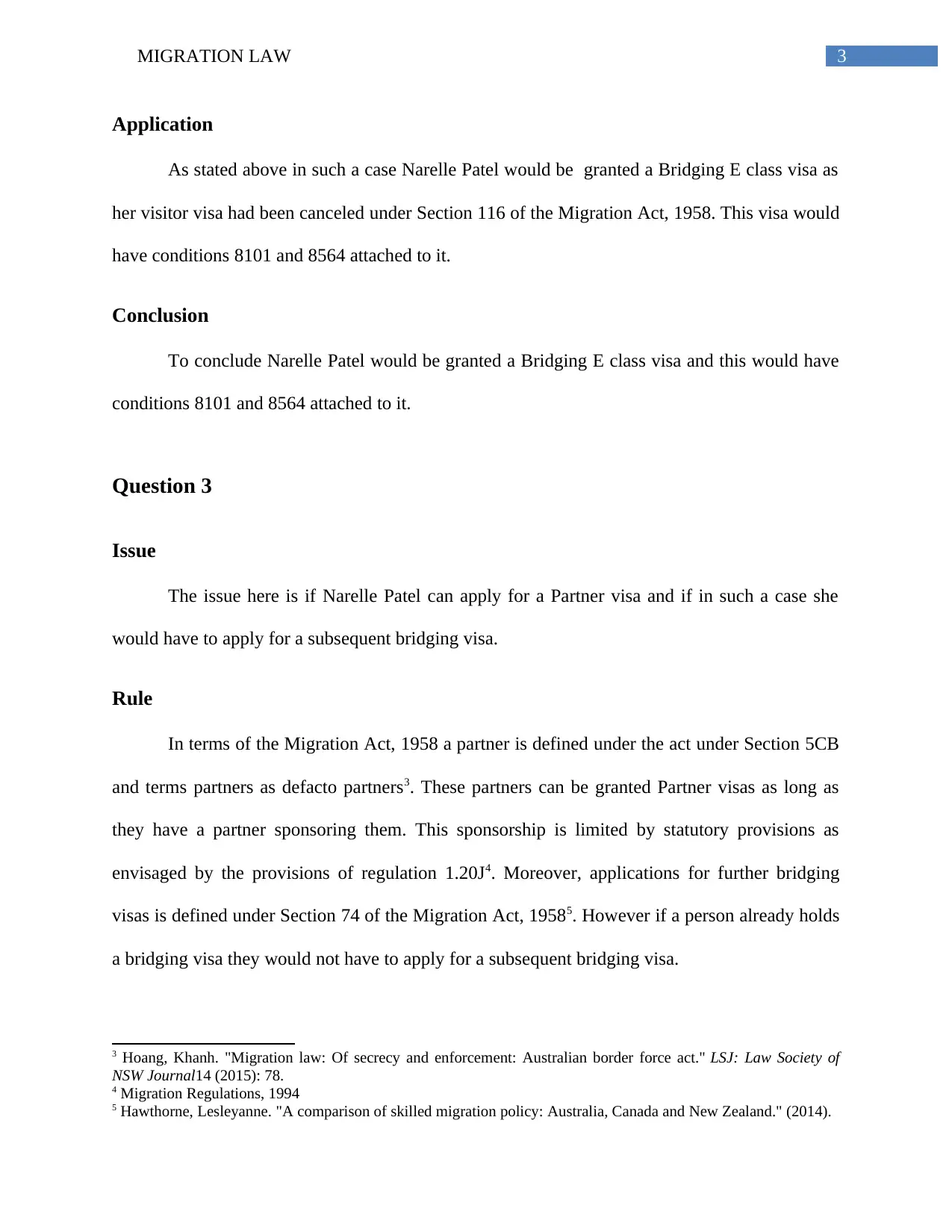
3MIGRATION LAW
Application
As stated above in such a case Narelle Patel would be granted a Bridging E class visa as
her visitor visa had been canceled under Section 116 of the Migration Act, 1958. This visa would
have conditions 8101 and 8564 attached to it.
Conclusion
To conclude Narelle Patel would be granted a Bridging E class visa and this would have
conditions 8101 and 8564 attached to it.
Question 3
Issue
The issue here is if Narelle Patel can apply for a Partner visa and if in such a case she
would have to apply for a subsequent bridging visa.
Rule
In terms of the Migration Act, 1958 a partner is defined under the act under Section 5CB
and terms partners as defacto partners3. These partners can be granted Partner visas as long as
they have a partner sponsoring them. This sponsorship is limited by statutory provisions as
envisaged by the provisions of regulation 1.20J4. Moreover, applications for further bridging
visas is defined under Section 74 of the Migration Act, 19585. However if a person already holds
a bridging visa they would not have to apply for a subsequent bridging visa.
3 Hoang, Khanh. "Migration law: Of secrecy and enforcement: Australian border force act." LSJ: Law Society of
NSW Journal14 (2015): 78.
4 Migration Regulations, 1994
5 Hawthorne, Lesleyanne. "A comparison of skilled migration policy: Australia, Canada and New Zealand." (2014).
Application
As stated above in such a case Narelle Patel would be granted a Bridging E class visa as
her visitor visa had been canceled under Section 116 of the Migration Act, 1958. This visa would
have conditions 8101 and 8564 attached to it.
Conclusion
To conclude Narelle Patel would be granted a Bridging E class visa and this would have
conditions 8101 and 8564 attached to it.
Question 3
Issue
The issue here is if Narelle Patel can apply for a Partner visa and if in such a case she
would have to apply for a subsequent bridging visa.
Rule
In terms of the Migration Act, 1958 a partner is defined under the act under Section 5CB
and terms partners as defacto partners3. These partners can be granted Partner visas as long as
they have a partner sponsoring them. This sponsorship is limited by statutory provisions as
envisaged by the provisions of regulation 1.20J4. Moreover, applications for further bridging
visas is defined under Section 74 of the Migration Act, 19585. However if a person already holds
a bridging visa they would not have to apply for a subsequent bridging visa.
3 Hoang, Khanh. "Migration law: Of secrecy and enforcement: Australian border force act." LSJ: Law Society of
NSW Journal14 (2015): 78.
4 Migration Regulations, 1994
5 Hawthorne, Lesleyanne. "A comparison of skilled migration policy: Australia, Canada and New Zealand." (2014).
Paraphrase This Document
Need a fresh take? Get an instant paraphrase of this document with our AI Paraphraser
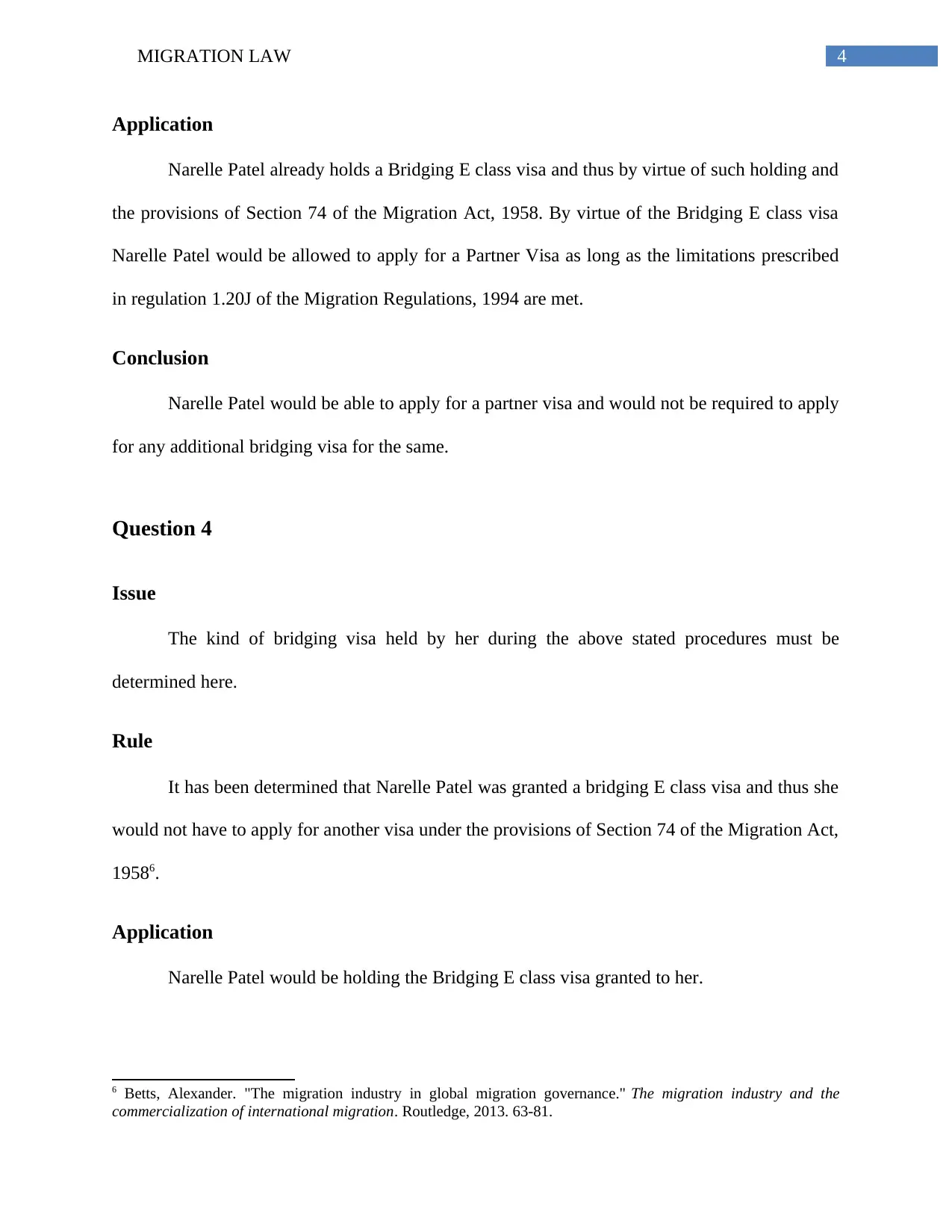
4MIGRATION LAW
Application
Narelle Patel already holds a Bridging E class visa and thus by virtue of such holding and
the provisions of Section 74 of the Migration Act, 1958. By virtue of the Bridging E class visa
Narelle Patel would be allowed to apply for a Partner Visa as long as the limitations prescribed
in regulation 1.20J of the Migration Regulations, 1994 are met.
Conclusion
Narelle Patel would be able to apply for a partner visa and would not be required to apply
for any additional bridging visa for the same.
Question 4
Issue
The kind of bridging visa held by her during the above stated procedures must be
determined here.
Rule
It has been determined that Narelle Patel was granted a bridging E class visa and thus she
would not have to apply for another visa under the provisions of Section 74 of the Migration Act,
19586.
Application
Narelle Patel would be holding the Bridging E class visa granted to her.
6 Betts, Alexander. "The migration industry in global migration governance." The migration industry and the
commercialization of international migration. Routledge, 2013. 63-81.
Application
Narelle Patel already holds a Bridging E class visa and thus by virtue of such holding and
the provisions of Section 74 of the Migration Act, 1958. By virtue of the Bridging E class visa
Narelle Patel would be allowed to apply for a Partner Visa as long as the limitations prescribed
in regulation 1.20J of the Migration Regulations, 1994 are met.
Conclusion
Narelle Patel would be able to apply for a partner visa and would not be required to apply
for any additional bridging visa for the same.
Question 4
Issue
The kind of bridging visa held by her during the above stated procedures must be
determined here.
Rule
It has been determined that Narelle Patel was granted a bridging E class visa and thus she
would not have to apply for another visa under the provisions of Section 74 of the Migration Act,
19586.
Application
Narelle Patel would be holding the Bridging E class visa granted to her.
6 Betts, Alexander. "The migration industry in global migration governance." The migration industry and the
commercialization of international migration. Routledge, 2013. 63-81.
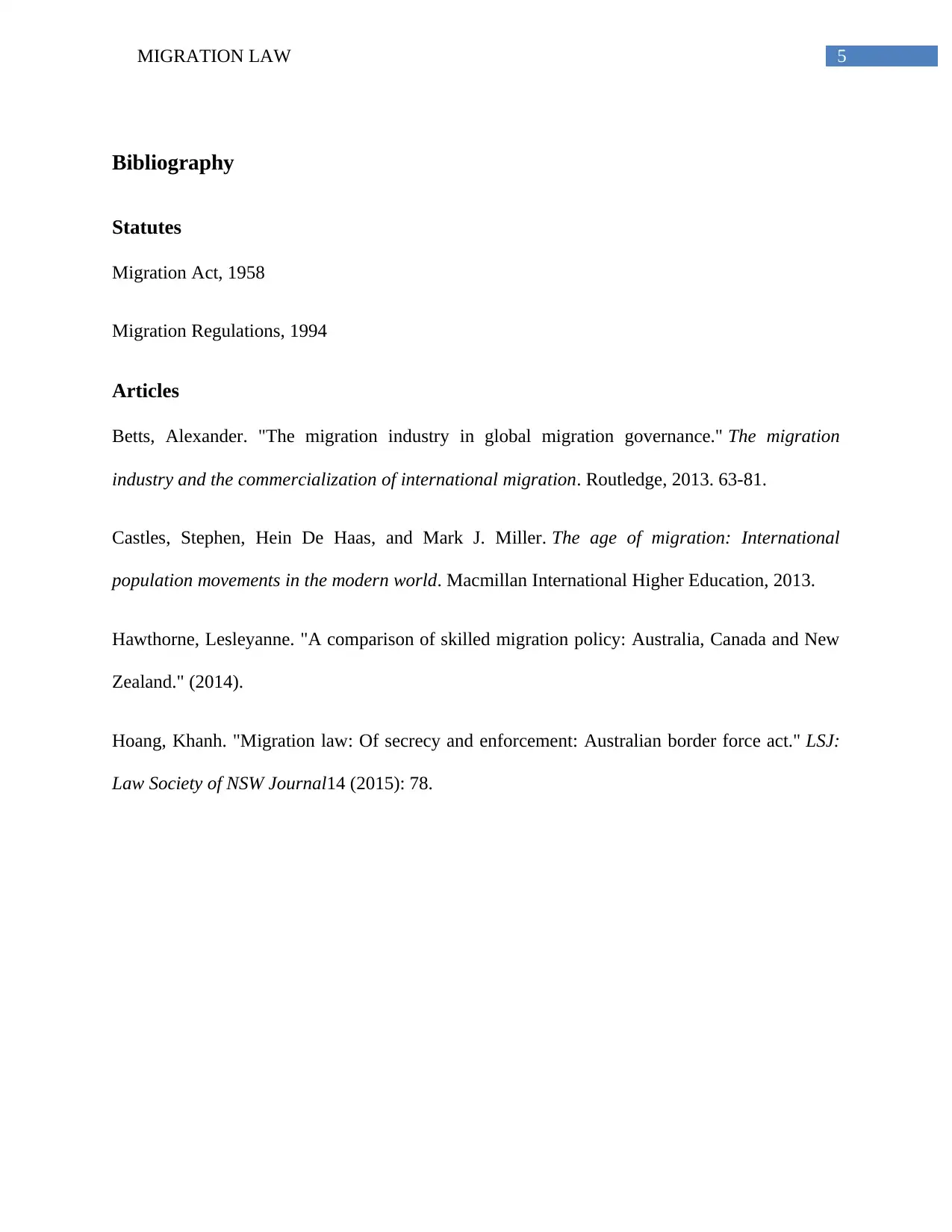
5MIGRATION LAW
Bibliography
Statutes
Migration Act, 1958
Migration Regulations, 1994
Articles
Betts, Alexander. "The migration industry in global migration governance." The migration
industry and the commercialization of international migration. Routledge, 2013. 63-81.
Castles, Stephen, Hein De Haas, and Mark J. Miller. The age of migration: International
population movements in the modern world. Macmillan International Higher Education, 2013.
Hawthorne, Lesleyanne. "A comparison of skilled migration policy: Australia, Canada and New
Zealand." (2014).
Hoang, Khanh. "Migration law: Of secrecy and enforcement: Australian border force act." LSJ:
Law Society of NSW Journal14 (2015): 78.
Bibliography
Statutes
Migration Act, 1958
Migration Regulations, 1994
Articles
Betts, Alexander. "The migration industry in global migration governance." The migration
industry and the commercialization of international migration. Routledge, 2013. 63-81.
Castles, Stephen, Hein De Haas, and Mark J. Miller. The age of migration: International
population movements in the modern world. Macmillan International Higher Education, 2013.
Hawthorne, Lesleyanne. "A comparison of skilled migration policy: Australia, Canada and New
Zealand." (2014).
Hoang, Khanh. "Migration law: Of secrecy and enforcement: Australian border force act." LSJ:
Law Society of NSW Journal14 (2015): 78.
⊘ This is a preview!⊘
Do you want full access?
Subscribe today to unlock all pages.

Trusted by 1+ million students worldwide
1 out of 6
Related Documents
Your All-in-One AI-Powered Toolkit for Academic Success.
+13062052269
info@desklib.com
Available 24*7 on WhatsApp / Email
![[object Object]](/_next/static/media/star-bottom.7253800d.svg)
Unlock your academic potential
Copyright © 2020–2025 A2Z Services. All Rights Reserved. Developed and managed by ZUCOL.





